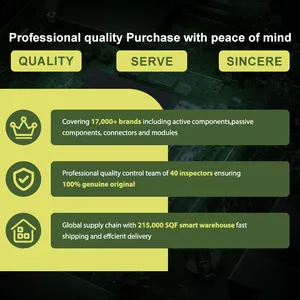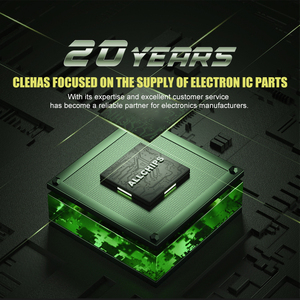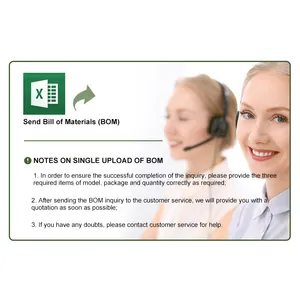(3500 products available)




































































































































































































The capacitive touch screen controller IC is a vital part of the capacitive touch screen that senses the changes in capacitance caused by a finger or stylus. These controller ICs come in different types, which vary based on configuration, number of channels, and power consumption.
Some common types include:
Multi-Touch
These controller ICs can detect and process multiple touch points simultaneously. They are ideal for systems that require gestures like pinch-to-zoom and multitasking. In recent years, the demand for multi-touch controller ICs has grown significantly and is expected to reach 1 billion by 2030.
Glove/Waterproof Touch Screen Controller
These Waterproof/Glove Capacitive Touch Controller ICs are designed specifically for industrial applications. They can detect touches even in conditions such as damp areas, extreme temperatures, and oily surfaces. On the other hand, glove touch screen controllers can detect touches even when the user wears gloves. They are widely used in the medical industry and areas with harsh weather conditions.
Single-Touch
It is the most basic type of touch screen controller IC. A single-touch controller can only detect one touch point at a time. They are commonly used in devices like smartphones and tablets.
Pressure Sensing
This type of IC detects not only the position of the touch but also the applied pressure. They enable the implementation of functions like force touch. For instance, applying pressure brings up the context menu, which saves time.
Gesture Recognition
These capacitive touch screen controller ICs are specifically designed to detect hand or body movements like swipe, pinch, and zoom.
They are useful in implementing dynamic and intuitive interfaces in devices like laptops and gaming consoles.
Multi-channel Capacitive Touch Controller IC
They have several analog capacitance measurement channels. These channels allow the measurement of the capacitance of several electrodes simultaneously.
Low Power IC
These touch screen controller ICs are applied in portable devices that require long battery life. They are characterized by Power Management Features such as Low Power Modes and Dynamic Voltage Scaling.
High Performance
High-performance PCAP touch screens have advanced noise immunity and multi-finger detection capabilities. They can work on thick gloves and wet surfaces. The high-performance controller IC is used in industrial and automotive applications.
Capacitive touch controllers have various functions and features. They detect and process touches on capacitive screens. Their specific functions and features usually vary from one model to the next. Some capacitive touch screen controller ICs have advanced features. They include configurable parameters. Users can adapt them to specific applications. Others have a multi-touch feature that enables simultaneous touch detection. They provide a better user experience.
Applications of capacitive touch screen controller IC are broad and diverse, mainly because capacitive touch technology has become the industry standard for creating user-friendly interfaces. According to a recent forecast, the global market for capacitive touch sensors is expected to hit a valuation of approximately $47.9 billion by 2030.
The widespread growth of this market presents useful opportunities for various industries, including those that deal with the supply of capacitive touch screen controller ICs. Various industries are becoming increasingly dependent on touch technology to enhance the functionality of their products. Some of the noteworthy applications include:
Selection of capacitive touch screen controller IC needs to be done carefully so that the right one is chosen for the project. Here are some of the factors that need to be considered:
Capabilities and Features
The first step is to understand the project's requirements and then select a controller that meets the necessary functionalities. Check things like the number of channels, sensors' size, multi-touch capabilities, haptic feedback, palm rejection, etc.
Performance
Users need to check out the touch sensitivity, accuracy, and responsiveness of the controller. It is important to choose one that has excellent performance and stable operation in different environmental conditions.
Compatibility
Controllers differ in firmware, and that is why users need to ensure that they match the requirements of their project. It is also essential to check that the touch screen controller IC is compatible with other components, such as the MCU and display interfaces.
Power Consumption
In battery-powered applications, it is critical to choose a controller with low power usage. Select a controller that has different power-saving features and consumption modes to help prolong battery life.
Environment Conditions
Check the temperature and humidity range where the device will be used. Make sure the capacitive touch screen controller can work in the environmental conditions without lowering its performance.
Budget and Cost
Evaluate the cost of the controller against its performance and features. Check if the additional features are worth their cost. It is also important to check the supplier's reliability and the after-sales support they offer.
Documentation and Community Support
Ensure that the manufacturer provides good documentation for easy integration. Also, it is a plus if the capacitive touch screen controller IC has a large user community for troubleshooting and support.
Q: Which touch screen controller IC is best?
A: The best controller IC is one that meets the application's specific needs. For instance, a controller for a mobile device must be very low power, while one for a fully portable equipment must be very environmental robust. Other factors to consider are multi-touch, latency, bom cost, and ease of design.
Q: What are the major features of capacitive touch controllers?
A: Major features include multi-touch, hover support, palm rejection and better noise immunity. Multi-touch allows many users to touch the screen at the same time. Hover support detects touch at a distance. Palm rejection enables only the intended touches to be registered by the screen. The screen ignores touches from larger body parts like the palm. Noise immunity ensures that only intended touches are registered even under noisy environments like industrial workspaces.
Q: What materials work best with capacitive touch screens?
A: Most materials will work with capacitive screens, but the touch controller chip works best with capacitive touch screen glass. The skin, which has some level of resistance, is the primary material used to touch screens. Other materials include gloves, water, anodized aluminum and plastics. It is important to consult the material compatibility section of the touch controller's datasheet to identify all the materials the screen can work with.
Q: What is the difference between a touch screen and a controller?
A: The difference is that a touch screen is a sensor that detects the location of a touch and converts it into an electric signal, while a controller is an IC that works with the touch sensor to convert the signal into digital data that can be read by the system the touch screen is compatible with. The controller then processes the data and sends it to the system.
Q: What is the difference between a capacitive and resistive touch controller?
A: A capacitive touch screen controller IC relies on the change in capacitance to detect a touch event, while a resistive touch controller works on the principle of resistance. In capacitive screens, an electric field is created around the sensor. When a user touches the screen, the capacitance at that point changes, and the controller detects the change. In contrast, in resistive screens, there are two layers with electrodes. When a user touches the screen, one layer touches the other, and the resistance at that point changes. The controller detects the change in resistance. It is important to note that only a finger or a tool like a stylus can work with capacitive touch screens, while resistive screens can be touched with almost anything.